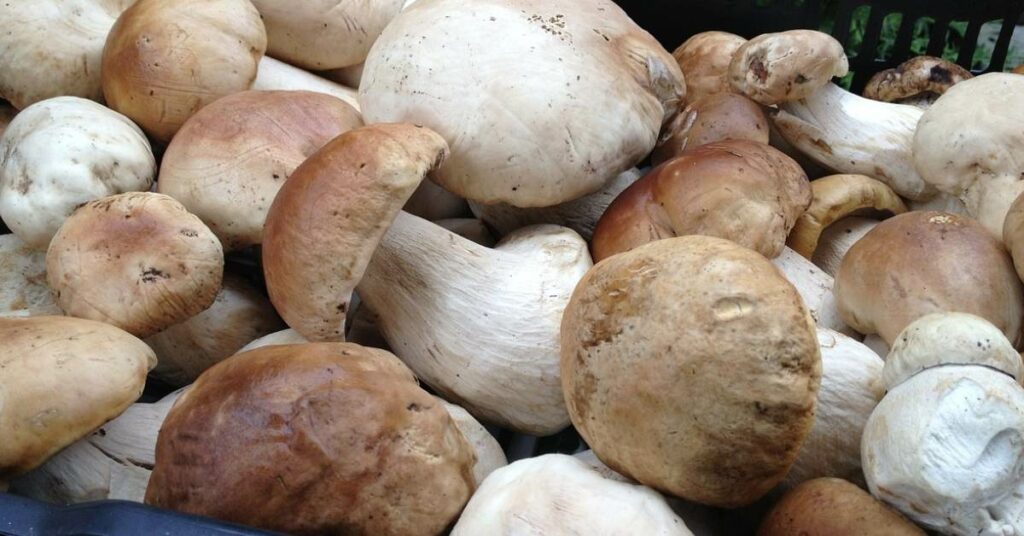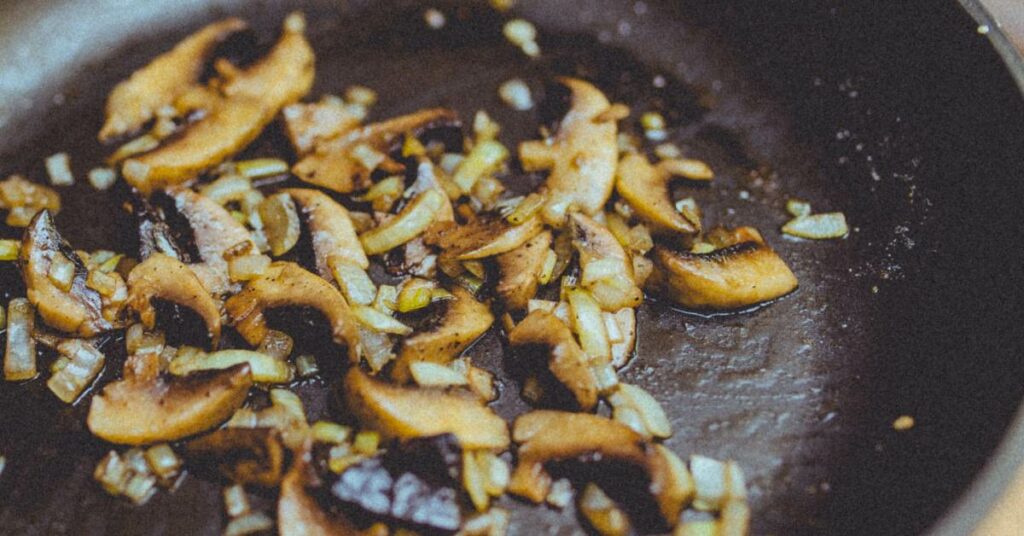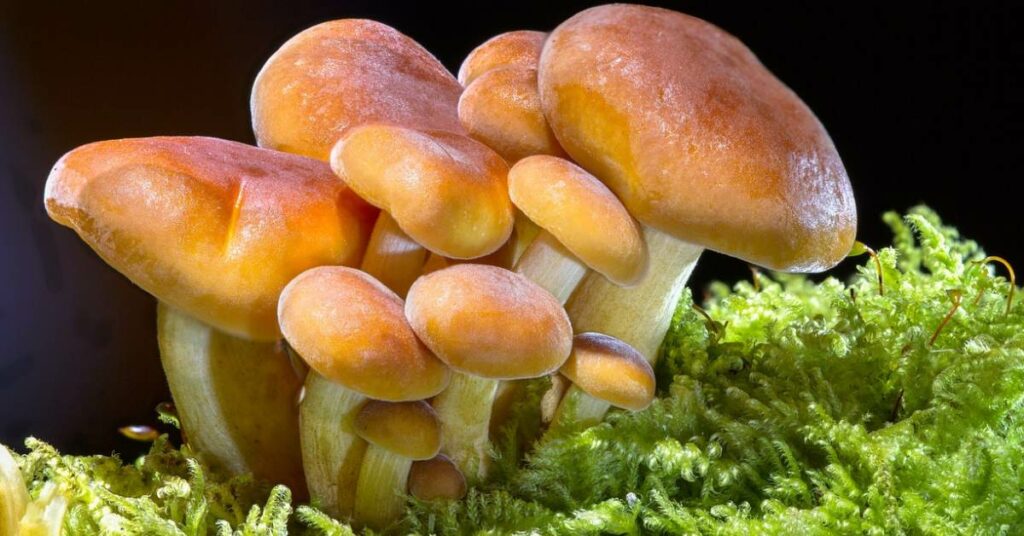If you love mushrooms, then a trip to Italy is a must…even if that “trip” is only to your local Italian market.
Italy is home to some of the best mushroom varieties in the world, and of course, once obtained the Italians REALLY know what to do with them. Let’s have a deeper dive into what you need to know about finding, choosing, and cooking Italian mushrooms.
Mushrooms in Italian
How do you say “mushroom” in Italian? The word is fungo in the singular, funghi in the plural. Yes, it sounds like fungus, which of course it is. Italians also love truffles (tartuffi), another type of fungus, very much prized in the north of Italy for the particular flavor they impart on various dishes.
However, you will also find that Italians have a love-fear relationship with mushrooms. These days we buy our mushrooms in the supermarket, and of course they are very safe to eat. But I recall my Italian grandfather refusing to eat mushrooms because his mother had told him a story of someone who had died from eating poison mushrooms.
“Tutti i funghi possono essere mangiati, alcuni però una volta sola.”
“All mushrooms can be eaten, but some however only one time.”
Some examples of Italian mushrooms are porcini, white button mushrooms, oyster mushrooms, chanterelles, and ovoli mushrooms. We will talk more about the specific varieties of Italian mushrooms in the section below.
Types Of Mushrooms Used in Italian Cooking
1. Porcini (Cep Mushroom)
Porcini mushrooms, also known as Boletus Edulis, have several characteristics that make them a popular ingredient in Italian cooking. Firstly, they have a unique and nutty flavor that adds depth and richness to dishes like risotto and soup. Secondly, they are high in protein and can be used as a meat substitute. Thirdly, their large caps have a spongy underside that melts down during slow cooking, creating a flavorful and rich sauce.
They also tend to grow in individual or small clusters of two or three, and sprout best during periods of warm weather and autumn showers.

2. Agaricus Bisporus (Portobello)
Portobello mushrooms, also known as Agaricus bisporus, are some of the most versatile and commonly grown mushrooms in Italy. They are often used in Italian cooking due to their mild flavor and ease of use.
These mushrooms can be easily cleaned before cooking, making them a popular choice for pasta dishes, risottos, and grilled meats. Portobello mushrooms are a great source of vitamins and minerals, contributing to the maintenance of the immune system and helping to combat cardiovascular diseases. They are also low in calories, making them a great option for those watching their weight.
Portobello mushrooms can be pan-sautéed with garlic and extra-virgin olive oil, grilled, or added to soups, stews, and other dishes.
3. Champignon
Another popular type of mushroom in Italy is known by various names, such as button or white mushrooms, or champignons.
Champignons are white or brown and are a popular way to add some depth to pasta sauces.
4. Funghi Dolci (Sweet Mushroom)
The most commonly used sweet mushrooms in Italian cuisine are finferli, also known as chanterelle mushrooms in English-speaking countries. They are orange in color and funnel-shaped, with a striped underside. They have a slightly tangy flavor and are one of the tastiest mushrooms around.
5. Porcini Secchi (Dried Porcini)
Dried porcini mushrooms have a brown and ochre cap with a white stipe or stem, and when sliced, have a smooth and creamy pale flesh inside. The most highly prized porcini have a chocolate-colored cap.
Porcini are found growing in symbiosis with the roots of trees, particularly chestnut, pine, acacia, and beech trees, in woodlands and forests in Tuscany. Oven-drying the mushrooms concentrates their flavor and evaporates 8,090 per cent of their weight.
Dried porcini are a versatile winter ingredient, used in risotto, pasta sauces, and stracotto, and can also be used to make a flavorful spread. They are all-natural with no preservatives or additives and are available seasonally.
6. Champignoni (Chanterelle)
Champignoni, or chanterelle mushrooms, are one of the most popular mushroom varieties in Italian cooking. They are highly sought after for their unique flavor and texture, which is both earthy and nutty. They are easily recognizable by their yellow color, funnel-like shape and ridges underneath the cap. This makes them perfect for sautéing, adding to sauces and stuffing. They are also known for their rich aroma and slightly sweet taste when fresh.
The reason why chanterelle mushrooms are so popular in Italian cooking is due to their versatility. They work in a variety of dishes, from pastas to sauces and stuffing, and they can add a special touch of flavor to a dish. They can also be used in salads, stir-fries, soups and risottos. They are also a great source of vitamins, minerals and antioxidants, making them a nutritious and delicious addition to any meal.
7. Sanguinelle (Bloody Di Rondelle)
The Sanguinelle or Bloody di Rondelle mushroom is an Italian mushroom commonly found in damp, calcareous forests and woods. Due to its distinctive red, concentric stripes, it has earned its name, which means “bloody” in Italian.
is notable for its firm texture and crispness, making it an excellent choice for grilling. It is also ideal for use in tomato, egg and potato sauces, as well as in salads and side dishes for white meats. Its thick, yellowish-white gills and cylindrical stalks make it a dish to be savored.
The key to cooking with Sanguinelle mushrooms is to choose the right cap, as the surface of the mushroom becomes increasingly scaly as it ages. Furthermore, a milky serum emerges from the orange hues when the mushroom is cut, which further adds to its unique flavor. This makes it an excellent main ingredient in rice and pasta dishes, as well as in salads, polenta and fried breading.
8. Morels
Morels (Morchella esculenta) are found in the wild and are characterized by their distinctive shape and honeycomb pattern of ridges and pits. They have a unique taste and aroma, and are often used in soups or stews, or for stuffing and baking.
They are typically sautéed in butter or oil and can be served alone as a side dish, or added to recipes for pasta, risotto, or other meals. The texture of the mushrooms is meaty and chewy, and they are often used to add depth and flavor to a dish. Morels should be cooked thoroughly to ensure they are safe to consume, as they are known to contain toxins that must be removed by cooking.
9. Trifolati (Mixed Mushrooms)
“Mixed mushrooms” are obviously made from a combination of different types of mushrooms. The most commonly used ingredients for mixed mushrooms include chanterelles, honey mushrooms, morels, yellow trumpets, porcini, chiodini, penny buns caps, pine mushrooms, parasols, russulas, Caesar’s agaric, and various species of black truffle, such as those from Trentino and the Colli Berici.
10. Funghi alla Strozzata (Narrow-Stalked Cup)
La strozzata or cuppa (from the dialectal name of the cuccuma) is a typical dish of the Romagna area (Emilia-Romagna). It is a mushroom soup made with a mixture of different types of mushrooms.
The most commonly used mushrooms are the nails (pioparelli), which are characterized by a yellowish-white color, with very scattered glands, a thin stem covered with white or yellowish scales, and a white, fibrous pulp with a slightly bitter taste.
Other mushrooms used in the preparation of this dish are the porcini, which are white in color with clear glands and a hollow stem; cockerels, which have spur-like caps, and morels, which are white in color with scattered glands.
Best Italian Mushrooms

Best Mushrooms for Pasta or Risotto
The best mushrooms for pasta and risotto are the Agaricus bisporus varieties (which include button or white mushrooms, champignons, and portobello mushrooms), finferli (also known as Chantarelle mushrooms), ovoli (also called “Caesar’s mushroom”), chiodini, and pioppini.
These mushrooms are all versatile and delicious when cooked with garlic, extra-virgin olive oil, fresh parsley, a hint of broth or white wine, and minced carrot and celery.
Finferli have a peppery flavor, ovoli are slightly sweet, champignon add depth to pasta sauces, porcini can be sliced and fried when fresh and make excellent risottos.
Pioppini are often used in pasta con funghi.
When dried, porcini should be soaked in hot water for 30 minutes and then cooked for about 10 minutes.
Best Mushrooms for Pizza
When it comes to making a delicious pizza, the right mushrooms can make all the difference. There are several types of mushrooms that are great for pizza, but the best ones are the Agaricus bisporus varieties (button or white mushrooms), Piopparelli, and Pleurotus ostreatus (oyster mushrooms).
Agaricus bisporus have a classic mushroom flavor, and they are easy to clean before cooking. They are perfect for sautéing with garlic and olive oil and adding to pizzas for a burst of flavor.
Piopparelli have a thick, whitish gills tending to light brown, and the flesh is white, tender in the cap and slightly more calloused in the stalk. This type of mushroom is great with all types of meat, so don’t be afraid to add these on your pizza next sausage or salami (“pepperoni”).
Lastly, oyster mushrooms, are perfect for grilling and adding to pizza. They should not be overcooked, as just a few minutes per side is enough. They add a unique flavor and texture to pizzas, and they are also great when breaded and cooked like cutlets.

Italian Mushrooms: How to Choose
When selecting Italian mushrooms, first, look for mushrooms that have a fresh, firm cap, and no dark, soft, or spotted area that could indicate that the mushroom is too mature.
Second, check the stalk for small holes, as these indicate the presence of worms.
Third, look for mushrooms that were freshly picked, as these are generally more reliable than those sold at large chain supermarkets.
Italian Mushrooms: How to Cook
How to Cook Italian Mushrooms:
1. Use any type of mushroom from the above list. This recipe will work for most types of mushrooms you’ll encounter in an American or Italian market, be it button mushrooms, cremini, or porcini.
2. Clean the mushrooms well: Wipe the mushroom caps with a damp kitchen towel. Trim the end or peel the tougher part of the stem if necessary.
3. Don’t move them too much in the pan: Cook the mushrooms in some olive oil over medium heat and move them minimally so they can brown and get full flavor.
4. Add some wine: Add enough broth or wine to just cover the bottom of the pan and stir to coat. Cook until it’s slightly reduced and the alcohol smell is cooked off if using the wine. Example:
In a large skillet over medium-high heat, sauté the mushrooms in 1 tablespoon olive oil. Add 3 tablespoons of white wine or broth to the skillet and stir to coat. Cook until the liquid is slightly reduced. Finish by adding 3 tablespoons of grated Pecorino cheese and stir to combine. Serve warm topped with an extra sprig of thyme or rosemary and a squeeze of lemon juice.
5. Cook mushrooms in the oven: If making a big batch, roast the mushrooms in one layer on a baking sheet. Example:
Preheat the oven to 400°F. Clean and trim the mushrooms, then spread them out on a baking sheet. Drizzle with 2 tablespoons extra-virgin olive oil and sprinkle with 3 smashed garlic cloves and 3 sprigs of thyme or rosemary. Roast in the preheated oven for 15-20 minutes until the mushrooms are golden and tender.

Pairing Italian Mushroom Recipes with Wine
Italian mushrooms are a delicious and flavorful ingredient that can be used in many dishes. Pairing them with the right wine, however, can take the dish to the next level.
The best wine to pair with mushrooms depends on how the mushrooms are cooked. For example, if the mushrooms are cooked with garlic, olive oil, and parsley, you may want to select a dry white wine, such as a Pinot Grigio or Chardonnay.
If the mushrooms are cooked with thyme, rosemary, and breadcrumbs, opt for a red wine, such as a Pinot Noir or Cabernet Sauvignon.

Where to Find Mushrooms in Italy
In Italy, you can find mushrooms in the forests of the Alps, the Apennine mountains, and other woodlands.
The wild mushroom season usually starts in April and lasts until early November, although in some regions such as Abruzzo, Molise, Campania, Calabria, Basilicata and parts of Sicily and Sardinia, the season can extend until late December.
Il piacere di trovare un fungo sta nel coglierlo nascosto nel suo angolo del bosco: un’emozione neppure lontanamente paragonabile al momento in cui si vede un paniere di funghi in vendita.
The pleasure of finding a mushroom lies in picking it when hidden in its corner of the wood: an emotion not even remotely comparable to the moment in which you see a basket of mushrooms for sale (at the supermarket).
Carlo Lapucci, Dictionary of Italian proverbs, 2006
The Mushroom’s Role in Italian Tradition
Mushrooms have had an important role in Italian tradition and culture for thousands of years. They have been used in a variety of dishes including pasta sauces, salads, risottos and pizzas, and Italians have relied on expert “fungaioli” (mushroom hunters) to distinguish between edible and poisonous varieties.
In the Middle Ages, porcini mushrooms from the Apennine mountains were picked, salted, and sold all across Europe.
In the modern era, mushroom cultivation has been developed to produce a higher quality product than what is found in the wild. This includes techniques used in France to cultivate mushrooms in caves and using American systems for mushroom beds that are placed over a substrate of compost.
These techniques are used to grow a variety of edible mushrooms including chanterelles, honey mushrooms, morels, yellow trumpets, porcini and chiodini.
Mushrooms are an essential ingredient in the cuisines of both Veneto and Trentino-Alto Adige and continue to be a valued part of Italian tradition and culture all over the country.
But nowadays, the only mushroom hunting you must do is online!
Mushrooms From Italy – FAQS
Where can I find Italian mushrooms?
If you’re looking for Italian mushrooms, you can find them in the forests of the Apennine mountains, the Alps, and other woodlands. You can also find prized wild mushrooms in the regions of Abruzzo, Molise, Campania, Calabria, Basilicata, and parts of Sicily and Sardinia. Additionally, mushroom farms can be found in the caves around Costozza as well as in the Berici Hills near Costozza, Cismon del Grappa and Sovizzo.
What are the most popular Italian mushroom varieties?
The most popular Italian mushroom varieties are Agaricus bisporus (button or white mushrooms, champignons, portobello mushrooms), Finferli (Chantarelle mushrooms), Ovoli (Caesar’s mushroom), Champignon (Portobello mushrooms), Porcini, Chiodini, and Pioppini.
What are some popular Italian mushroom dishes?
A favorite Italian mushroom dish is risotto con i funghi porcini – a risotto with porcini mushrooms. The porcini mushrooms add depth and richness to the sauce, making it a favorite. Other dishes that can be made with mushrooms include funghi trifolati, which is cooked mushrooms with garlic and olive oil, and pasta con funghi, which is usually prepared with pioppini mushrooms. Another delicious dish is the tagliatelle con i funghi porcini, which is a pasta dish made with porcini mushrooms. Polenta can also be prepared with mushrooms and herbs and then grilled with some Taleggio chees
What is the best way to store Italian mushrooms?
The best way to store Italian mushrooms is to keep them cool, dry, and dark. This can be done by storing them in a cool and dry place, in a paper bag, or in the refrigerator.
How can I tell if Italian mushrooms are fresh?
Look for yellowish-brown tinge on the undersides of the caps, as this is a sign of over-ripeness. Also inspect them for tiny holes in the stem, which is a sign of worms. Avoid those with dark, soft, or spotted caps that may be too mature. Also, examine the stalk for small holes, which indicate worms.
What are the 4 types of mushrooms?
The four primary categories of mushrooms are: saprotrophic, mycorrhizal, parasitic, and endophytic. Within each of these broad categories, there are many varieties. However, it’s important to note that not all mushrooms in these categories are safe to consume, and some may even be poisonous or psychoactive.
